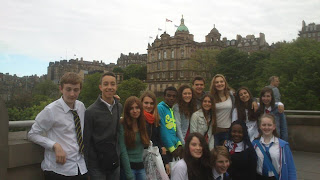Two representatives from our school, David and Aina, went to Glasgow in June 2013 for the final event there. This is what they read to summarise what we have been doing. And these are some of the pictures they took.
We’re two of the many
students that have been involved in Connecting Classrooms for the last three
years. At the beginning we were told that this project dealt with fighting
social exclusion and, to tell you the truth, we were quite lost. Now it makes
sense to us and we are more aware of the community and the reality that
surrounds us.
In our first
year, we started having some training meetings in Alella with students from the
other Catalan schools. We played games to get to know each other and we talked
about social isolation. We liked sharing a project with our neighbour schools
and meeting new friends.
We also sent some
students' profiles and Christmas cards and some gifts to our partners in
Scotland, Bosnia and Poland.
We recorded a
video of the school and we explored the similarities and differences between
our environments, homes and schools through the view from our windows. Biel,
won the first prize of the photograph competition. (This is the photo.)
In the second
year, we also did training sessions in Alella with our neighbour schools and
Irene, another classmate, was chosen to represent our school to go to Glasgow.
Since then, we
have been going to one old people' s home in our town and we have done several
things with and for them, from singing to playing dominoes not only with them
but also with some little kids with risk
at social exclusion. We wrote some messages together and we blew up a hundred
balloons, each of them containing a message. This activity was related to the
“Marathon against poverty” organised by TV3.
This year we have
been dealing with the hindrances that disabled people come up with and the
loneliness and other difficulties that the elderly endure. The starting point
was a lecture given by Raquel Soto, a woman that suffers from cerebral palsy.
She is a very active and funny woman and from then on we have never seen people
in wheelchairs the same way. She complained that there were not only physical
barriers but also psychological ones and she was right. And her testimony helped
us a lot.
Neil Harbisson
also came to give us a lecture, He is an interesting guy who cannot see colours
and thanks to an electronic eye he listens to colors. It was a superb speech
and we loved it.
And our community
of old people are helping us to detect the architectonic barriers that they
have to face in their daily life. We hope that with the diagnose that we' ve
done on the town, the authorities will do something to avoid the obstacles they
meet.
And last, but not
least. We want to thank the British Council for giving us the chance to visit
the Scottish Schools, We loved them, our teachers also loved them and took many
ideas from there that want to carry out. It was a rewarding experience that we
will always remember.



























































